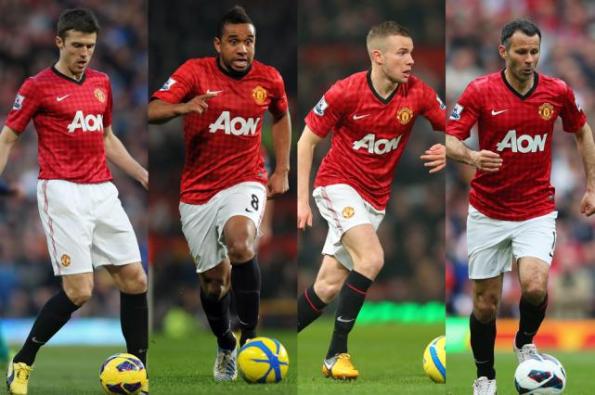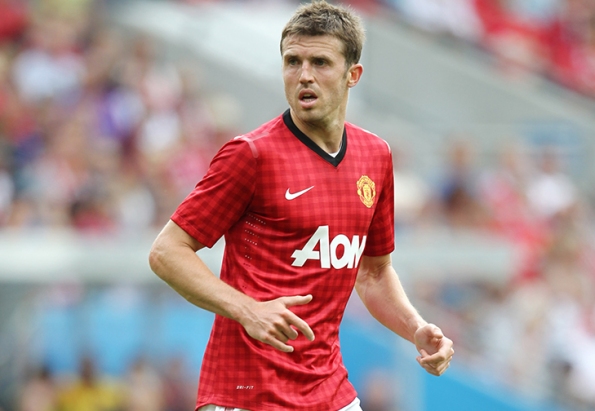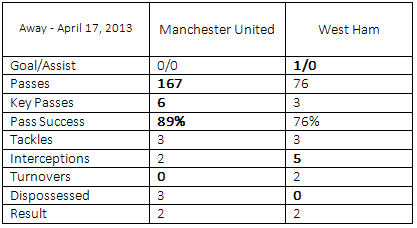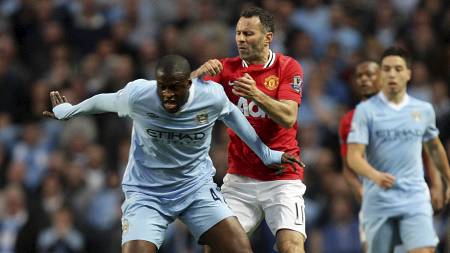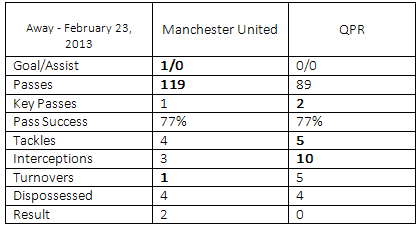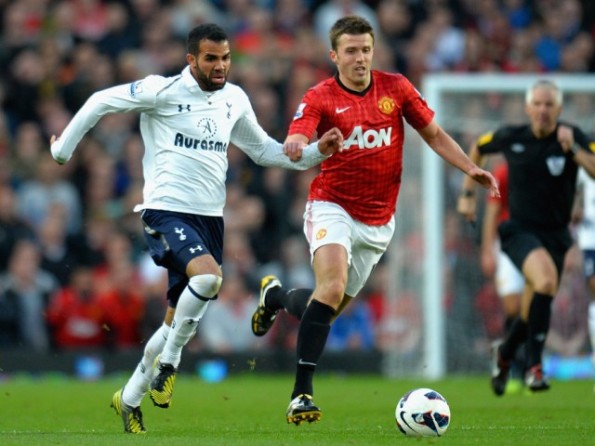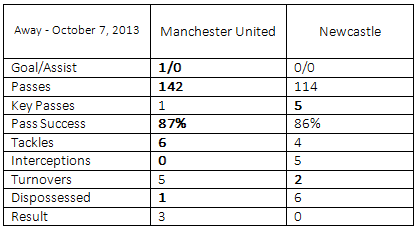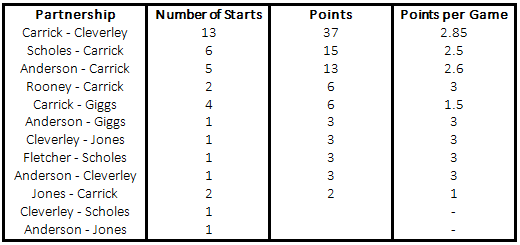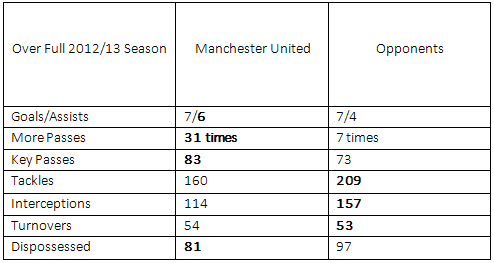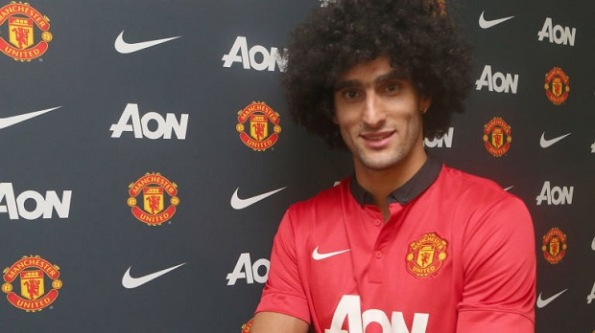Archive
Manchester United’s Central Midfield Exposed
As the new Premier League season got under way, Manchester United began the defence of their title in unfamiliar territory. For the first time in the league’s history, Sir Alex Ferguson would not be at the club’s helm. Some would argue that the Scot’s achievements during the last few years at his club were among his greatest ever. The argument is based upon a widely circulated notion that the current squad is not the best he’s ever had, especially as it does not possess a dominant or quality central midfield partnership. There were even calls for David Moyes, the new manager, to sign 2 recognized central midfielders during the summer transfer window. He ended up with one, his former Everton player, the Belgian Marouane Fellaini.
The purpose of this article is to analyze the criticisms laid above both objectively and tangibly. In order to do that, we will establish a few facts and put the “performances” of the central midfield under the microscope on a match-by-match basis over during the course of their title winning season in 2012/13. Whilst it is unlikely that a conclusive assessment to either extreme may be formed, it is more than likely that both sides of the argument would become clearer to the audience, who can, consequently, provide educated assessments on the subject.
Who Played There in 2012/13?
Manchester United’s main central midfield partnership last season saw Michael Carrick team up with Tom Cleverley. A third player joined them quite often as Ferguson favored going with 3 in midfield during many of the games (either as a 4-2-3-1 or a 4-3-3). However, the said player would usually play in an advanced role, something Wayne Rooney grew accustomed to. The statistics below exhibit some key stats from the players who filled the 2 deeper midfield roles last season. Phil Jones sat ahead of the defence in a few matches, however also played in central defence and right back and therefore did not complete enough matches in the former role to warrant inclusion.
Michael Carrick was almost an ever-present last season. For many, he was the unsung hero of United’s success and has vastly improved over the past 2 seasons. He has begun contributing defensively, an aspect of his game which had a lot to be desired for in the past. Cleverley started the season brightly but critics argued that he faded as the season went on into a crucial period. Giggs and Scholes offered experienced heads as partners for Carrick and between each other posted impressive contributions, or so it seemed. Brazilian, Anderson, continues to frustrate critics and onlookers. Although technically brilliant, his lack of consistency has prevented him from settling into a regular role in his favored central midfield position.
What We Learn from the Statistics
Michael Carrick comes up in the top 20 in the Premier League from central midfield when it comes to interceptions made. At the same time, in terms of tackling he placed in the top 30 from central midfield. His overall placing in each of those categories is significantly higher when it comes to actual interceptions and tackles as many of his counterparts played far less games but places higher due to the per game ratios used. In terms of assists, he comfortably placed himself in the top 10 from the position. Carrick also provided the 3rd most number of passes per game and in fact the most total number of passes completed in the Premier League. Interestingly, 37% of his passes were forward ones whilst only 8% of them backwards. His percentage of passes forward was higher than that of Santi Cazorla, Mikael Arteta, Yaya Toure or Steven Gerrard among others. The Englishman has been dogged by criticism over his career with respect to the type of passes he undertakes. As he has aged, the criticism has waned and the level of appreciation for his talents increased. He’s currently arguably the best (and maybe only) true English central midfielder in the ilk of a Spaniard like Xabi Alonso or Xavi.
Assessing Performances in Game-Time
Its difficult to review the above statistics and make a conclusive assessment, one way or the other, in terms of United’s central midfield. What may help would be to statistically review their performances head-to-head against counterparts in the Premier League during the course of last season. With that in mind, we’ve assessed all those games and highlighted a sample size which looks at a variety of matches, from wins, to draws as well as defeats defeats, both home and away, in environments that may be more telling for the reader.
In April, towards the end of the season, but crucially before they had clinched the title, United took on West Ham at Upton Park. During that game they came up against the imposing duo of Mohammed Diame and Gary O’Neill. West Ham’s partnership attempted almost half the number of passes of their counterparts. Almost every key aspect of a contest between the two partnerships was more or less similar. Although Diame did score a crucial goal which gained the home side a draw. West Ham also put in slightly better work in the middle when it came to intercepting balls from United. Although that could also be partly due to the amount of passes through attempted by the away side.
A few days earlier, United hosted noisy neighbors Manchester City at Old Trafford. It was set to be a huge step towards winning back the title but by the time the full time whistle was heard, Man City had clawed themselves back into the title race, albeit in vain. United’s central midfield succeeded with 86% of their passes whilst their City counterparts led by Yaya Toure hit 88%. United were on the defensive foot and this was further exhibited with the central midfield achieving 12 tackles and 7 interceptions as opposed to 5 and 2 respectively for the visitors. They also turned the ball over 3 times to their opponents whilst City’s partnership were immaculate in that respect. City went on to win 2-1 at Old Trafford. The earlier match up between the two was at the Etihad Stadium on December 9, 2012. Again, Man City fared a little better than United in the passing accuracy game with 82% against 78%, although the number of passes attempted was far more balanced this time around. Almost every other stat was on par with each other in the area. However, City contributed a goal from the area even though United succeeded with 2 key passes from the deeper position against City’s nil. The game was balanced just as the midfield battle seemed to be, but United took the victory with a last-gasp goal by Robin van Persie.
Other key clashes included United’s February clash with QPR at Old Trafford. United ran out 2-0 winners and this included one goal from central midfield, a rarity for the home side. Passing accuracy was 77% in the middle of the park for both sides, even though United attempted more passes through their central midfielders. QPR were a bit more “cavalier” from that part of the pitch and completed 2 key passes against 1 but this also meant they turned the ball over 5 times in the crucial area against the solitary time United did so.
United’s two clashes with Tottenham were both interesting and revealing. The first one took place at the end of September, 2012, at Old Trafford. Spurs central midfield is far more physical in nature and much more aggressive. Spurs were happy to sit back and let United dominate the play in that area instead choosing to go in hard with tackles and intercept the ball in key areas, launching quick counter attacks. United’s central midfield attempted almost 3 times as many passes as the visitors, with an 89% accuracy, which exhibits the fact that a lot of the passing took place in deeper and safe areas. Spurs on the under hand used a quick tempo, ran with the ball far more from central midfield and hit an 84%% pass accuracy in the area. However, they intercepted the ball 13 times, more than 3 times the figure United’s duo achieved. They intercepted the ball twice as many times as the hosts as well. Interestingly, they also hit 4 key passes in the game and that is an impressive achievement by any measure by any central midfield of two players, especially as they only had a total of 56 passes, as opposed to United’s 256, through which the home side only achieved 2 key passes. Spurs ended up winning 3-2 thanks to an assist directly coming from the central midfield. The return game was in January at White Hart Lane and this time around Spurs were far more adventurous, and the possession stats in the area were much more balanced with Spurs passing it around more through their duo. Furthermore, Spurs succeeded with 5 key passes, another high figure as opposed to the 1 that United’s partnership achieved. United succeeded with twice as many tackles in the area and were dispossessed less and turned the ball over less than the opponents. The final result was a draw.
Other close encounters including those against Swansea and Norwich away, in the first half of the season. United failed to win either, drawing against the former and losing against the latter. But little or no blame can be attached to the central midfield when one looks at the stats. They were better in possession, and dominated passing too. They achieved more key passes in both matches. They also out-tackled their counterparts.
United’s away clash at St. James Park, historically a difficult place for the visitors in October, 2012, was another interesting match-up when it came to central midfield. Newcastle’s partnership of Tiote and Cabaye, on paper look a good combination, albeit both physically on the small side. United’s partnership were just about more accurate in the passing department, getting close to 87% success there. Interestingly, Newcastle’s central midfield had 5 key passes and also had more interceptions and less turnovers. They still lost the game 3-0 and this included a rare goal contribution from United’s partnership.
Finally, Manchester United’s two-games at Merseyside against Liverpool and Everton provided a similar pattern of stats. Firstly, against the blues in August, United’s partnership attempted almost two and a half times as many passes and were far more accurate with the ball than their opponents. They also out-tackled their counterparts whilst the other key stats were similar, except a key assist from Everton which resulted in the only goal of the match. Against the reds, United saw less of the ball in the area. Almost every other key stat was shared there too. This time around Liverpool scored a goal through one of its central midfielders. Nevertheless, United won 2-1.
Drawing Conclusions
What have we learned having put Manchester United’s central midfield under the microscope? Its difficult to be definitive in providing a final assessment to the initial question posed in the article. However, it is possible to deduce certain realities when it comes to the topic at hand.
1) Manchester United did not provide consistency to its ideal central midfield partnership last season. This could partly be down to availability but at the same time, Sir Alex Ferguson’s insistence on squad rotation made it difficult for at least 1 of the spots in the partnership to be filled consistently. However, looking at the performances and stats of some of the players, one could argue that other than Michael Carrick no one really warranted a regular spot in the position either.
2) Goals were hard to come by from the position. Only 7 goals from 81 starts (including some starts for Anderson, Giggs and Cleverly in other positions) and 32 sub appearances. To put this into perspective Marouane Fellaini scored 11 times on his own last season, England captain Steven Gerrard scored 9 times, Newcastle’s Cabaye and Arsenal’s Arteta had 6 each, whilst Liverpool’s maligned central midfielder Josh Henderson contributed 5 from 18 starts. However as a partnership, United did not get out-scored by their direct opponents in the games they played (7 goals against 7).
3) In the creativity department, United’s central midfielders contributed 6 assists between them over the course of the season. To put this into context, Yaya Toure had 5 on his own throughout last season. Swansea’s De Guzman had 6, whilst Fellaini had 5. Steven Gerrard led all central midfielders with 9 last season. United’s total of 6 was shared between 3 players (with a further 3 not contributing), and was led by Carrick’s 4 assists.
4) Although they were rarely “out-fought” in head-to-head match-ups, the stats show that over the course of the season, when it came to the defensive side of the game, the numbers posted were solid but not spectacular. Other than Carrick, no other player broke the 2 per game ratio when it came to tackles and interceptions and only 1 other player broke the 50 passes per game ratio. On first inspection that suggests that Carrick plays the ball while his partner works harder to get it back or get into the box to contribute the finishing touches to an attack. However, this was not the case as none of his partners were prolific or improved upon his defensive numbers. However, as a partnership over the course of the season United’s central midfield posted 30% less tackles than their direct opponents and just under 40% less interceptions.
5) Five central midfield partnerships hit double figures when it came to tackles successful against Man United in a game. United’s only managed to do so once.
6) On a game to game basis United’s central midfield were not sloppy in possession dominating the passing 31 times. The 7 occasions during which they were “out-passed” included Arsenal (a), Chelsea (h), Everton (h), Spurs (a), Wigan (a), Man City (h) and Liverpool (a).
7) The Carrick – Cleverley starting partnership was the most successful one followed by Carrick – Scholes. In fact, Carrick formed one-half of the 4 most successful partnerships they had. Ryan Giggs formed the least successful partnership over the course of the season when he teamed up with Carrick, seeing United lose half the games they started together.
8) Whilst United’s partnership usually keeps their counterparts on par with themselves, they do not dominate them either other than in the passing department.
9) United’s partnerships turned the ball over more than their counterparts over the course of the season.
10) On 6 occasions did United’s central midfielders post 100+ passes in a game. Carrick did so 4 times whilst Scholes twice. In fact, against against Spurs at home and Villa away they both had 100+ games. Carrick’s season high 134 during the latter, whilst Scholes high was 148 against the former.
Final Thoughts
It is harsh to suggest that Manchester United’s central midfield is its Achilles Heel. However, when you look at the fact that they are the champions and have the league’s top scorer as well as one of its meanest defenses, it is also difficult to suggest other positions that should be strengthened ahead of the central midfield. A lack of goals and final-third creativity is evident. At the same time, whilst most of the other 19 sides in the Premier League have a favored partnership in the middle of the park, United have failed to cement one. This may largely be attributed to Ferguson’s style of management. Moyes may choose a different avenue and rotate less in key areas such as this.
Furthermore, the signing of Marouane Fellaini brings both goals and assists into the side as well as better defensive numbers than all of United’s current midfielders, even though some of his numbers had been posted through playing in a more advanced role. Nevertheless, a Carrick – Fellaini partnership may be what significantly improves United’s central midfield allowing it to dominate its opponents far more in that area.
With special thanks to Who Scored for their range of statistics on the 2012/13 Premier League season
